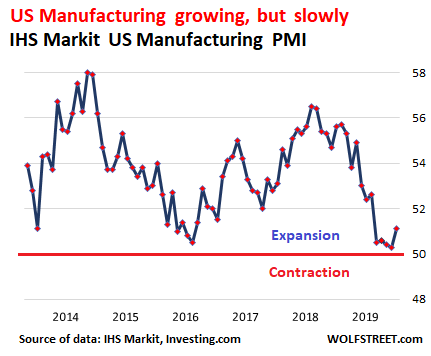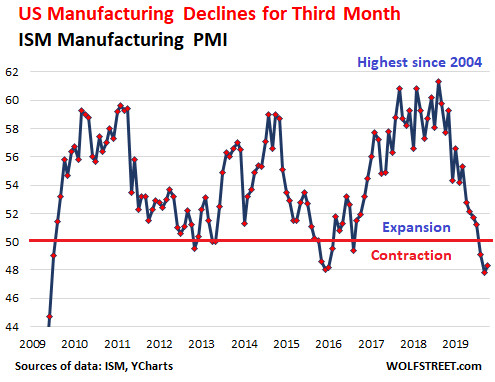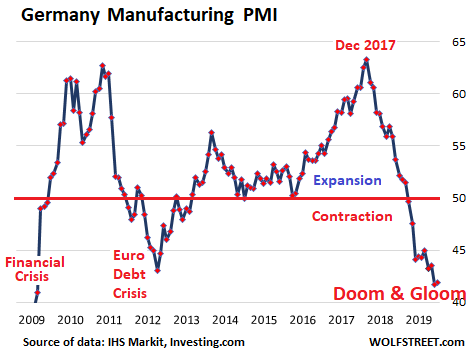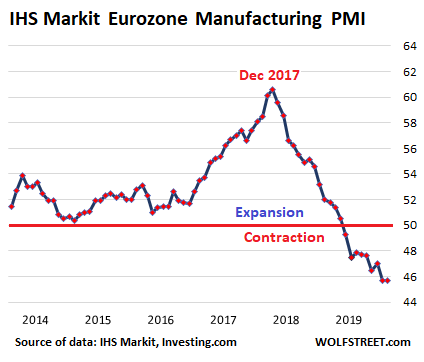U.S. Barely Cleanest Dirty Shirt Among Manufacturing Giants
by Wolf Richter, Wolf Street:
 US & China come up with conflicting data, Germany in crisis, Japan has “excessive” downside risks, South Korea faces “headwinds from all sides.”
US & China come up with conflicting data, Germany in crisis, Japan has “excessive” downside risks, South Korea faces “headwinds from all sides.”
Manufacturing in the US is growing at crawl-speed or is actually declining, depending on who the beholder is. China appears to be on a similar track, with manufacturing export orders in particular trouble. But the other manufacturing giants – Germany, Japan, and South Korea – are not so lucky.
On Friday, two major beholders released their views on the US manufacturing sector: The IHS Markit US Manufacturing PMI, which saw growth in October picking up a tad for the second month in a row, from stall-speed over the summer; and the ISM Manufacturing PMI, which saw manufacturing declining in October but declining at a slightly slower rate than in the month before. The IHS Markit US Manufacturing PMI first:

These “Purchasing Managers Indices” (PMIs) are based on how a panel of executives of manufacturing companies – names are not disclosed – see various aspects of their own businesses, such as new orders, production, and employment. Values over 50 mean growth (the more the value is above 50, the faster the growth); values below 50 mean contraction.
“Tentative signs of renewed vigor are appearing in the US manufacturing sector, with the survey’s production gauge having now risen for three successive months to suggest that the soft patch bottomed out in July,” the IHS Markit report said.
“Growth of new orders hit a six-month high, fueled in part by a renewed increase in exports, prompting producers to take on more staff, with payroll numbers rising at the quickest pace since May.”
The ISM Manufacturing Report, had a drearier view of the US manufacturing sector, with October being the third month in a row of declines, but the decline was slightly less fast than the month before – that’s the good news, so to speak, “but sentiment remains more cautious than optimistic” (data via YCharts):

The only sub-index that expanded was, amazingly, drumroll, New Export Orders, which suddenly surged into growth territory (50.4), from deep contraction in September (41). All of the remaining the sub-indices contracted, including: New Orders (49.1), Production (46.2), Employment (47.7), Backlog of orders (44.1), and Imports (45.3).
“Food, Beverage & Tobacco Products remains the strongest industry sector and Transportation Equipment the weakest sector. Overall, sentiment this month remains cautious regarding near-term growth,” the report summarized.
German manufacturers, doom-and-gloom galore.
Germany has implemented an industrial policy that favors exports of manufactured goods, and is particularly focused on the auto industry, not only making cars and components, but making the machinery and robots for auto manufacturing plants. And when global auto sales suddenly go into decline, as they’ve been doing, and when demand for manufactured goods in general slows, well then, it’s time to get into doom-and-gloom mode.
The preliminary IHS Markit/BME Germany Manufacturing PMI for October, at 41.9, along with September (41.7), remained at the lowest point since the Financial Crisis, confronting Germany with the sharpest contraction among the manufacturing powerhouses:

“Staffing numbers fell to the greatest extent for nearly ten years amid the widespread paring of temporary and contract workers,” the report said. In terms of business sentiment, “manufacturers remained strongly pessimistic about the outlook, though expectations rebounded further from August’s record low.”
Eurozone
The doom-and-gloom situation in Germany, the largest economy in the Eurozone, is dragging down the overall manufacturing sector of the Eurozone, with the preliminary IHS Markit Eurozone Manufacturing PMI remaining deeply in contraction mode, at 45.7 for October, same as in September, the ninth month in a row of shrinkage:

Even as Germany is slithering down the slope, manufacturing output in France, the second largest economy in the Eurozone, returned to growth mode: “A key divergence between France and Germany remained exports, with the former seeing modest growth in new business from abroad while Germany’s exports remained in steep decline,” the report said.
Loading...



